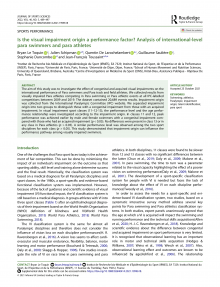-
Le Toquin et Al 2021 PDF-4.78 Mo
Journal of Sports Sciences
Bryan Le Toquin, Julien Schipman, Quentin De Larochelambert, Guillaume Saulière, Stephanie Duncombe & Jean-François Toussaint
ABSTRACT : The aim of this study was to investigate the effect of congenital and acquired visual impairments on the international performance of Para swimmers and Para track and field athletes. We collected results from visually impaired Para athletes competing in Para swimming or Para athletic events at all IPC-labelled competitions between 2009 and 2019. The dataset contained 20,689 events results. Impairment origin was collected from the International Paralympic Committee (IPC) website. We separated impairment origin into two groups to distinguish those with a congenital impairment from those with an acquired impairment. In visual impairment sport classes (11–12-13), the performance level and the age performance relationship were investigated according to the impairment origin. In classes 11 and 12, peak performance was achieved earlier by male and female swimmers with a congenital impairment compared with those who had an acquired impairment (p < 0.05). No differences were present in class 13 or in any class in Para athletics (p > 0.05). A similar performance level was observed among the two sport disciplines for each class (p > 0.05). This study demonstrated that impairment origin can influence the performance pathway among visually impaired swimmers.

